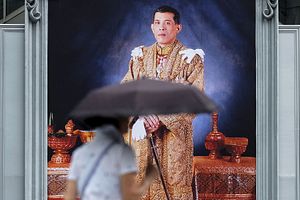On October 13, 2016, King Bhumibol passed away. His son, Vajiralongkorn, ascended the throne on December 1, 2016. In stark contrast to what had been feared, the transition went smoothly – the king made only gradual and limited changes in the composition of the Privy Council and maintained his president, Prem Tinsulanonda, in a remarkable display of continuity with his father’s reign. With the help of the military government of Prayut Chan-o-cha, who seized power in the May 22, 2014 coup d’etat, the new king revised, then promulgated, the Kingdom of Thailand’s 20th Constitution on April 6, 2017.
Upon ascending the throne, the new king made it clear that he intended to rule as a neoabsolutist king, in close alliance with the military, and under the shield of authoritarian law.
A New, Neoabsolutist King
Absolutism came late to Siam. At the end of the 19th century, King Chulalongkorn traveled to Europe where he became rather impressed with Napoleon III’s authoritarian constitution. He asked for an English summary and tried to replicate it for his own kingdom – his article 2 stated that “the King has absolute power; there is nothing above.” Although his constitutional project was aborted, King Chulalongkorn managed to consolidate his power, centralize government around his person, and turn himself into an absolute sovereign. Later, the Empire of Japan’s Meiji Constitution, inspired by the 19th century reactionary constitutions such as that of Prussian King Frederick William IV, provided the very model for early 20th century Asian constitutionalism. The Meiji Constitution proclaimed the emperor’s sovereignty, not the people’s, and gave him full powers – while strict lèse-majesté laws protected him from criticism.
A sense of the neoabsolutist nature of the regime inaugurated last year by King Vajiralongkorn can be grasped through an analysis of the ceremony accompanying the king’s promulgation of the kingdom’s 20th constitution. The king chose April 6, 2017, the anniversary of the founding of the Chakri dynasty, to promulgate the new text. This choice was made in order to better link royalty and the constitution, and to symbolically re-enact the myth of “granted constitutionalism.” The myth holds that Thailand entered into the era of constitutionalism and democracy on December 10, 1932 through the benevolent granting of a constitution to the people of Siam by King Rama VII – not through the revolutionary overthrow of the absolute monarchy by the People’s Party on June 24,1932.
In a royal palace room filled with golden regalia and tapestry, the ceremony brought together ambassadors, members of the ruling junta and the constitution-drafting committee, privy councilors and other high-ranking officials. While they all stood in lines for two hours in their suffocating uniforms, the king sat on his imposing golden throne. Without uttering a single word, he signed the three gold-plated copies of the constitution, folded in the traditional format of the Three Seals Law. The copies had been offered to him on a golden bowl by a kneeling and bowing officer – as the king is too sacred to be given an object from hand to hand.
From the 2017 Thai Constitution, only the preamble – which embodies the “spirit” of the text – was read aloud. It referred to King Rama VII’s “original” granting of the “first” Constitution of Siam in December 1932. The myth of “granted constitutionalism,” according to which sovereignty lies with the King, was enshrined in the text. Apart from the preamble, at the time the king signed, nobody knew what exactly was in the body of the text. Indeed, the king had in the previous weeks asked for revisions to be made by a committee specifically appointed for that purpose, and the resulting text had not been disclosed to the public. There is no better hint at royal sovereignty than the exercise of the king’s constituent power.
Meanwhile, Prayut Chan-o-cha, the country’s military dictator, kneeled down in front of Vajiralongkorn: his rule was then legitimized, and associated with the monarchy. The king sat still: he was not constitutionally required to swear an oath of upholding the constitution, specifically because he is the one granting it. His authority is not constituted by the constitution, it is constitutive of the constitution – the monarchy’s institutional body preexists the law. In this symbolic endeavor, the king resembled his father. Yet associating the entire Chakri dynasty to the birth of Thai constitutionalism as a whole constituted a rewriting of history that his father wouldn’t probably have dared to do.
Another event showed the unprecedented daring of the new regime when it comes to rewriting history to establish the king’s sovereignty. A few days after the ceremony, a historical plaque commemorating the 1932 revolution in front of Ananda Samakhom Hall was replaced by a plaque glorifying the monarchy. The revolutionary note, “Here, on 24 June 1932, at dawn, the People’s Party instituted the first Constitution of the country, for the betterment of the nation” became the conservative “Loyalty and love for the triple gems – everybody’s heart must be pure because the King is kind; that is how the State prospers.” The original plaque, which had been inaugurated in 1936 after the abdication of King Prajadhipok, marked the exact place where the People’s Party members had gathered to launch a coup that would overthrew one of the last independent absolute monarchies of the world.

































